Comparison of Local Mean Age of Air between Displacement Ventilation System and Mixing Ventilation System in Office Heating Conditions during Winter
Abstract
:1. Introduction
2. Materials and Methods
2.1. Description of Office
2.2. Numerical Method
2.3. Experimental Method
3. Results and Discussion
4. Conclusions
Author Contributions
Funding
Institutional Review Board Statement
Informed Consent Statement
Data Availability Statement
Conflicts of Interest
References
- World Health Organization. WHO Coronavirus (COVID-19) Dashboard. 2022. Available online: https://covid19.who.int (accessed on 24 August 2022).
- Zhu, N.; Zhang, D.; Wang, W.; Li, X.; Yang, B.; Song, J.; Zhao, X.; Huang, B.; Shi, W.; Lu, R.; et al. A novel coronavirus from patients with pneumonia in China, 2019. N. Engl. J. Med. 2020, 382, 727–733. [Google Scholar] [CrossRef] [PubMed]
- Fears, A.C.; Klimstra, W.B.; Duprex, P.; Hartman, A.; Weaver, S.C.; Plante, K.S.; Mirchandani, D.; Plante, J.A.; Aguilar, P.V.; Fernández, D.; et al. Persistence of severe acute respiratory syndrome coronavirus 2 in aerosol suspensions. Emerg. Infect. Dis. 2020, 26, 2168–2171. [Google Scholar] [CrossRef] [PubMed]
- Yu, I.T.; Li, Y.; Wong, T.W.; Tam, W.; Chan, A.T.; Lee, J.H.; Leung, D.; Ho, T. Evidence of airborne transmission of the severe acute respiratory syndrome virus. N. Engl. J. Med. 2004, 350, 1731–1739. [Google Scholar] [CrossRef] [PubMed]
- Tellier, R.; Li, Y.; Cowling, B.J.; Tang, J.W. Recognition of aerosol transmission of infectious agents: A commentary. BMC Infect. Dis. 2019, 19, 101. [Google Scholar] [CrossRef] [PubMed]
- Morawska, L.; Milton, D.K. It is time to address airborne transmission of coronavirus disease 2019 (COVID-19). Clin. Infect. Dis. 2020, 71, 2311–2313. [Google Scholar] [CrossRef] [PubMed]
- Lee, S.Y.; Choi, S.H.; Park, J.E.; Hwang, S.; Kwon, K.T. Crucial role of temporary airborne infection isolation rooms in an intensive care unit: Containing the COVID-19 outbreak in South Korea. Crit. Care 2020, 24, 238. [Google Scholar] [CrossRef]
- Prather, K.A.; Marr, L.C.; Schooley, R.T.; McDiarmid, M.A.; Wilson, M.E.; Milton, D.K. Airborne transmission of SARS-CoV-2. Science 2020, 370, 303–304. [Google Scholar]
- Miller, S.L.; Nazaroff, W.W.; Jimenez, J.L.; Boerstra, A.; Buonanno, G.; Dancer, S.J.; Kurnitski, J.; Marr, L.C.; Morawska, L.; Noakes, C. Transmission of SARS-CoV-2 by inhalation of respiratory aerosol in the Skagit Valley Chorale superspreading event. Indoor Air 2021, 31, 314–323. [Google Scholar] [CrossRef]
- Tang, L.; Liu, M.; Ren, B.; Chen, J.; Liu, X.; Wu, X.; Huang, W.; Tian, J. Transmission in home environment associated with the second wave of COVID-19 pandemic in India. Environ. Res. 2022, 204, 111910. [Google Scholar] [CrossRef]
- Klepeis, N.E.; Nelson, W.C.; Ott, W.R.; Robinson, J.P.; Tsang, A.M.; Switzer, P.; Behar, J.V.; Hern, S.C.; Engelmann, W.H. The National Human Activity Pattern Survey (NHAPS): A resource for assessing exposure to environmental pollutants. J. Expo. Sci. Environ. Epidemiol. 2001, 11, 231–252. [Google Scholar] [CrossRef]
- Chen, C.; Jiang, M.; Luo, X.; Tai, H.; Jiang, Y.; Yang, M.; Xie, G.; Su, Y. Ni-Co-P hollow nanobricks enabled humidity sensor for respiratory analysis and human-machine interfacing. Sens. Actuators B Chem. 2022, 370, 132441. [Google Scholar] [CrossRef]
- Chen, C.; Xie, G.; Dai, J.; Li, W.; Cai, Y.; Li, J.; Zhang, Q.; Tai, H.; Jiang, Y.; Su, Y. Integrated core-shell structured smart textiles for active NO2 concentration and pressure monitoring. Nano Energy 2023, 116, 108788. [Google Scholar] [CrossRef]
- Li, Y.; Qian, H.; Hang, J.; Chen, X.; Cheng, P.; Ling, H.; Wang, S.; Liang, P.; Li, J.; Xiao, S.; et al. Probable airborne transmission of SARS-CoV-2 in a poorly ventilated restaurant. Build. Environ. 2021, 196, 107788. [Google Scholar] [CrossRef] [PubMed]
- Shen, Y.; Li, C.; Dong, H.; Wang, Z.; Martinez, L.; Sun, Z.; Handel, A.; Chen, Z.; Chen, E.; Ebell, M.H.; et al. Community outbreak investigation of SARS-CoV-2 transmission among bus riders in Eastern China. JAMA Intern. Med. 2020, 180, 1665–1671. [Google Scholar] [CrossRef] [PubMed]
- Rickman, H.M.; Rampling, T.; Shaw, K.; Martinez-Garcia, G.; Hail, L.; Coen, P.; Shahmanesh, M.; Shin, G.Y.; Nastouli, E.; Houlihan, C.F. Nosocomial transmission of coronavirus disease 2019: A retrospective study of 66 hospital-acquired cases in a London teaching hospital. Clin. Infect. Dis. 2021, 72, 690–693. [Google Scholar] [CrossRef] [PubMed]
- Blomquist, P.B.; Bolt, H.; Packer, S.; Schaefer, U.; Platt, S.; Dabrera, G.; Gobin, M.; Oliver, I. Risk of symptomatic COVID-19 due to aircraft transmission: A retrospective cohort study of contact-traced flights during England’s containment phase. Influenza Other Respir. Viruses 2021, 15, 336–344. [Google Scholar] [CrossRef] [PubMed]
- Sami, S.; Vuong, N.; Miller, H.; Priestley, R.; Payne, M.; Licata-Portentoso, G.; Drobeniuc, J.; Petersen, L.R. SARS-CoV-2 Infection and Mitigation Efforts among Office Workers, Washington, DC, USA. Emerg. Infect. Dis. 2021, 27, 669. [Google Scholar] [CrossRef]
- Lee, J.; Park, S.H.; Sung, G.B.; An, I.H.; Lee, K.R.; Hong, S.P.; Yook, S.J.; Koo, H.B. Effect of air cleaner on reducing concentration of indoor-generated viruses with or without natural ventilation. Aerosol Sci. Technol. 2021, 55, 1288–1303. [Google Scholar] [CrossRef]
- Bramiana, C.N.; Aminuddin, A.M.R.; Ismail, M.A.; Widiastuti, R.; Pramesti, P.U. The Effect of window placement on natural ventilation capability in a Jakarta high-rise building unit. Buildings 2023, 13, 1141. [Google Scholar] [CrossRef]
- Noh, K.C.; Yook, S.J. Evaluation of clean air delivery rates and operating cost effectiveness for room air cleaner and ventilation system in a small lecture room. Energy Build. 2016, 119, 111–118. [Google Scholar] [CrossRef]
- Szekeres, S.; Kostyák, A.; Szodrai, F.; Csáky, I. Investigation of ventilation systems to improve air quality in the occupied zone in office buildings. Buildings 2022, 12, 493. [Google Scholar] [CrossRef]
- Akbari, V.; Salmanzadeh, M. Numerical evaluation of the effect of air distribution system and location on performance of a portable air cleaner. Sci. Technol. Built Environ. 2019, 25, 34–45. [Google Scholar] [CrossRef]
- Aziz, M.A.; Gad, I.A.; El Shahat, F.A.; Mohammed, R.H. Experimental and numerical study of influence of air ceiling diffusers on room air flow characteristics. Energy Build. 2012, 55, 738–746. [Google Scholar] [CrossRef]
- Ning, M.; Mengjie, S.; Mingyin, C.; Dongmei, P.; Shiming, D. Computational fluid dynamics (CFD) modelling of air flow field, mean age of air and CO2 distributions inside a bedroom with different heights of conditioned air supply outlet. Appl. Energy 2016, 164, 906–915. [Google Scholar] [CrossRef]
- Méndez, C.; San José, J.F.; Villafruela, J.M.; Castro, F. Optimization of a hospital room by means of CFD for more efficient ventilation. Energy Build. 2008, 40, 849–854. [Google Scholar] [CrossRef]
- Ren, C.; Xi, C.; Wang, J.; Feng, Z.; Nasiri, F.; Cao, S.J.; Haghighat, F. Mitigating COVID-19 infection disease transmission in indoor environment using physical barriers. Sustain. Cities Soc. 2021, 74, 103175. [Google Scholar] [CrossRef]
- Behne, M. Indoor air quality in rooms with cooled ceilings.: Mixing ventilation or rather displacement ventilation? Energy Build. 1999, 30, 155–166. [Google Scholar] [CrossRef]
- Park, H.J.; Holland, D. The effect of location of a convective heat source on displacement ventilation: CFD study. Build. Environ. 2001, 36, 883–889. [Google Scholar] [CrossRef]
- Yin, Y.; Xu, W.; Gupta, J.K.; Guity, A.; Marmion, P.; Manning, A.; Gulick, B.; Zhang, X.; Chen, Q. Experimental study on displacement and mixing ventilation systems for a patient ward. HVAC&R Res. 2009, 15, 1175–1191. [Google Scholar]
- Ahn, H.; Rim, D.; Lo, L.J. Ventilation and energy performance of partitioned indoor spaces under mixing and displacement ventilation. In Building Simulation; Springer: Berlin/Heidelberg, Germany, 2018; pp. 561–574. [Google Scholar]
- Wang, J.; Yang, J.; Yu, J.; Xiong, F. Comparative characteristics of relative pollution exposure caused by human surface chemical reaction under mixing and displacement ventilation. Build. Environ. 2018, 132, 225–232. [Google Scholar] [CrossRef]
- Wei, G.; Chen, B.; Lai, D.; Chen, Q. An improved displacement ventilation system for a machining plant. Atmos. Environ. 2020, 228, 117419. [Google Scholar] [CrossRef]
- Zhao, W.; Mustakallio, P.; Lestinen, S.; Kilpeläinen, S.; Jokisalo, J.; Kosonen, R. Numerical and experimental study on the indoor climate in a classroom with mixing and displacement air distribution methods. Buildings 2022, 12, 1314. [Google Scholar] [CrossRef]
- Rencken, G.K.; Rutherford, E.K.; Ghanta, N.; Kongoletos, J.; Glicksman, L. Patterns of SARS-CoV-2 aerosol spread in typical classrooms. Build. Environ. 2021, 204, 108167. [Google Scholar] [CrossRef] [PubMed]
- Kaczmarczyk, J.; Melikov, A.; Fanger, P.O. Human response to personalized ventilation and mixing ventilation. Indoor Air 2004, 14, 17–29. [Google Scholar] [CrossRef] [PubMed]
- Kacira, M.; Sase, S.; Okushima, L. Optimization of vent configuration by evaluating greenhouse and plant canopy ventilation rates under wind-induced ventilation. Trans. ASAE 2004, 47, 2059–2067. [Google Scholar] [CrossRef]
- Zhang, X.; Weerasuriya, A.U.; Tse, K.T. CFD simulation of natural ventilation of a generic building in various incident wind directions: Comparison of turbulence modelling, evaluation methods, and ventilation mechanisms. Energy Build. 2020, 229, 110516. [Google Scholar] [CrossRef]
- Yin, H.; Li, Y.; Deng, X.; Han, Y.; Wang, L.; Yang, B.; Li, A. Performance evaluation of three attached ventilation scenarios for tiny sleeping spaces. Build. Environ. 2020, 186, 107363. [Google Scholar] [CrossRef]
- ANSYS FLUENT 12.0 User’s Guide. Available online: https://www.afs.enea.it/project/neptunius/docs/fluent/html/ug/main_pre.htm (accessed on 1 September 2022).
- Bartak, M.; Cermak, M.; Clarke, J.A.; Denev, J.; Drkal, F.; Lain, M.; Macdonald, I.A.; Majer, M.; Stankov, P. Experimental and numerical study of local mean age of air. In Proceedings of the 7th International Building Performance Simulation Association Conference, Rio de Janeiro, Brazil, 13–15 August 2001; pp. 773–779. [Google Scholar]
- Lee, J.; Noh, J.H.; Noh, K.C.; Kim, Y.W.; Yook, S.J. Effect of a system air conditioner on local air quality in a four-bed ward. Aerosol Air Qual. Res. 2021, 21, 200533. [Google Scholar] [CrossRef]
- Noh, J.H.; Lee, J.; Noh, K.C.; Kim, Y.W.; Yook, S.J. Effects of hospital ward curtains on ventilation in a four-bed hospital ward. Aerosol Air Qual. Res. 2018, 18, 2643–2653. [Google Scholar] [CrossRef]
- NHANES National Health and Nutrition Examination Survey III. Body Measurements (Anthropometry) Manual. 1988. Available online: https://stacks.cdc.gov/view/cdc/53134 (accessed on 15 September 2022).
- Liu, X.; Liu, X.; Zhang, T. Influence of air-conditioning systems on buoyancy driven air infiltration in large space buildings: A case study of a railway station. Energy Build. 2020, 210, 109781. [Google Scholar] [CrossRef]
- Park, S.H.; Lee, K.R.; Yook, S.J.; Koo, H.B. Enhancement and homogenization of indoor air quality in a classroom using a vertical airflow ventilation scheme. Toxics 2022, 10, 545. [Google Scholar] [CrossRef] [PubMed]
- KOSIS. Distribution of Average Height by Gender by Age and Province by Province: General. Available online: https://kosis.kr/statHtml/statHtml.do?orgId=350&tblId=DT_35007_N130&conn_path=I2 (accessed on 28 February 2023).

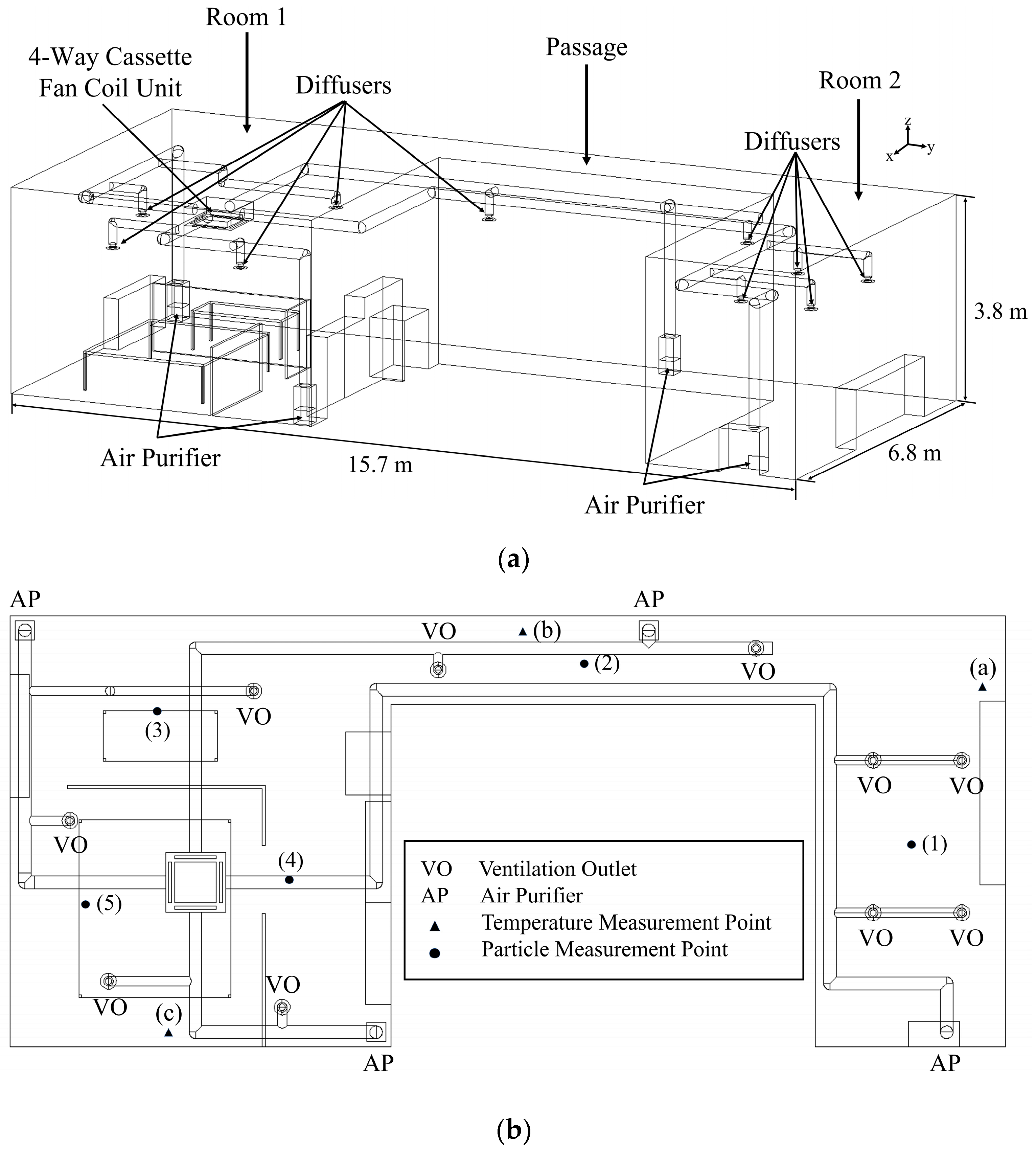
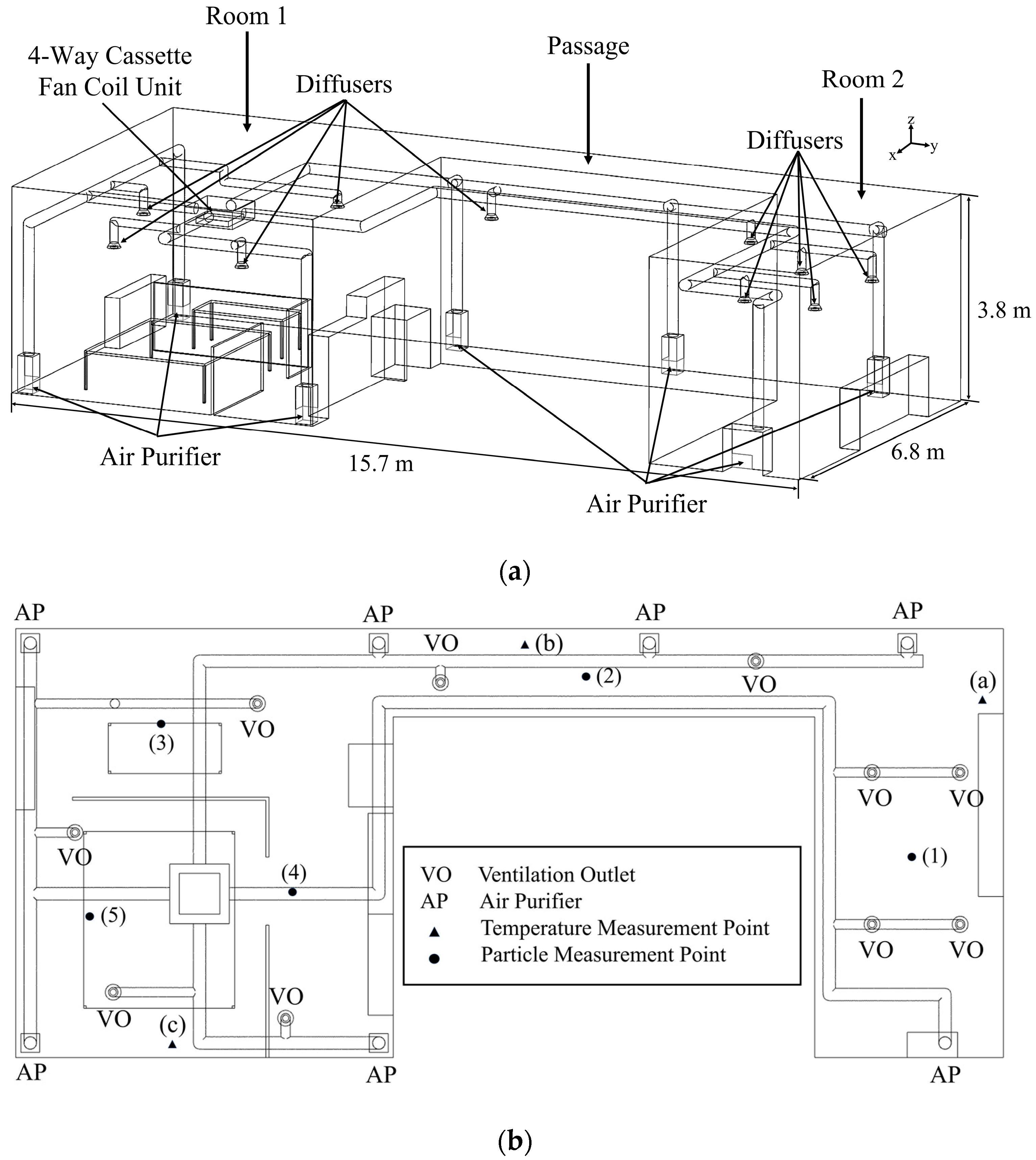
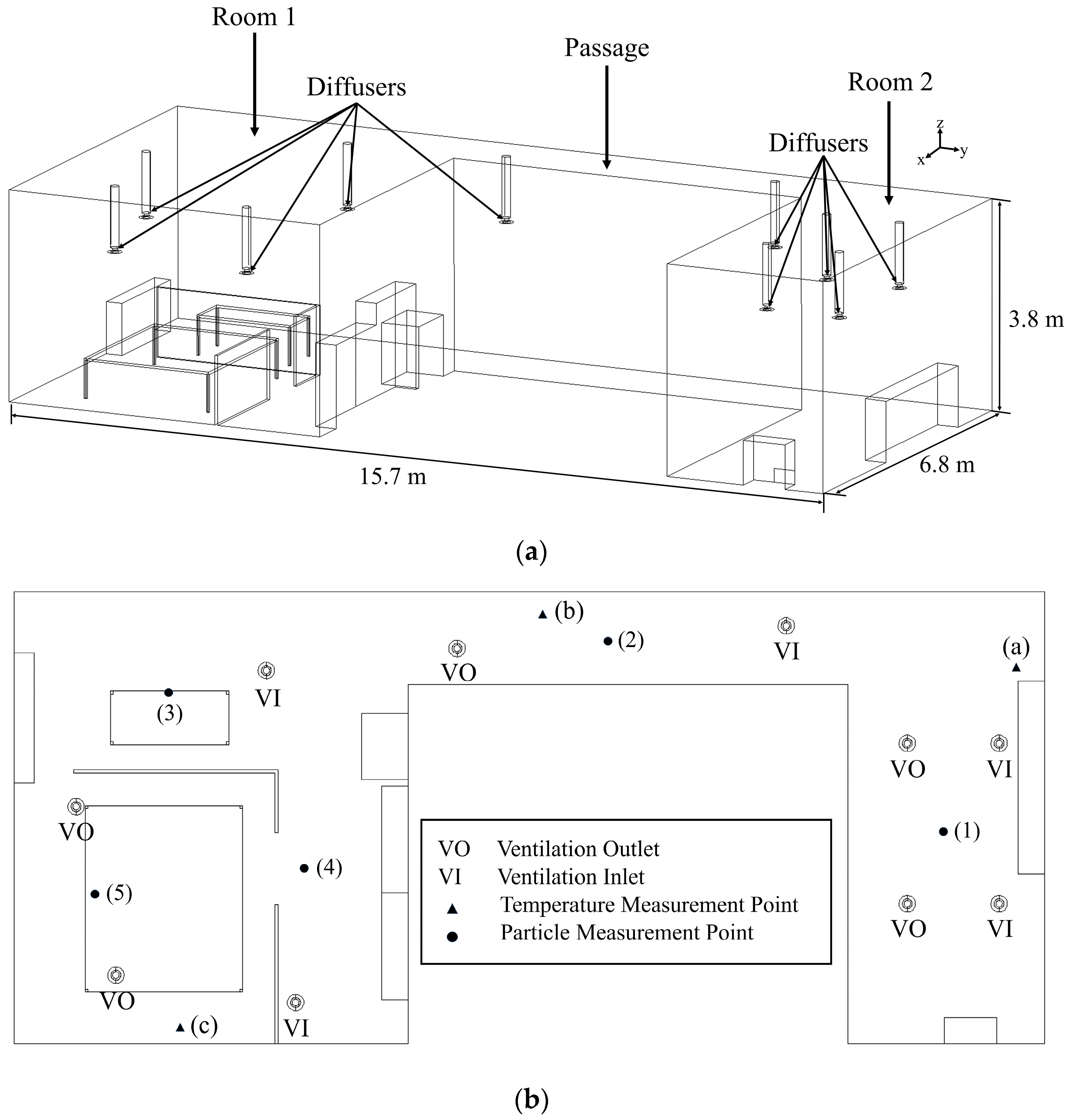
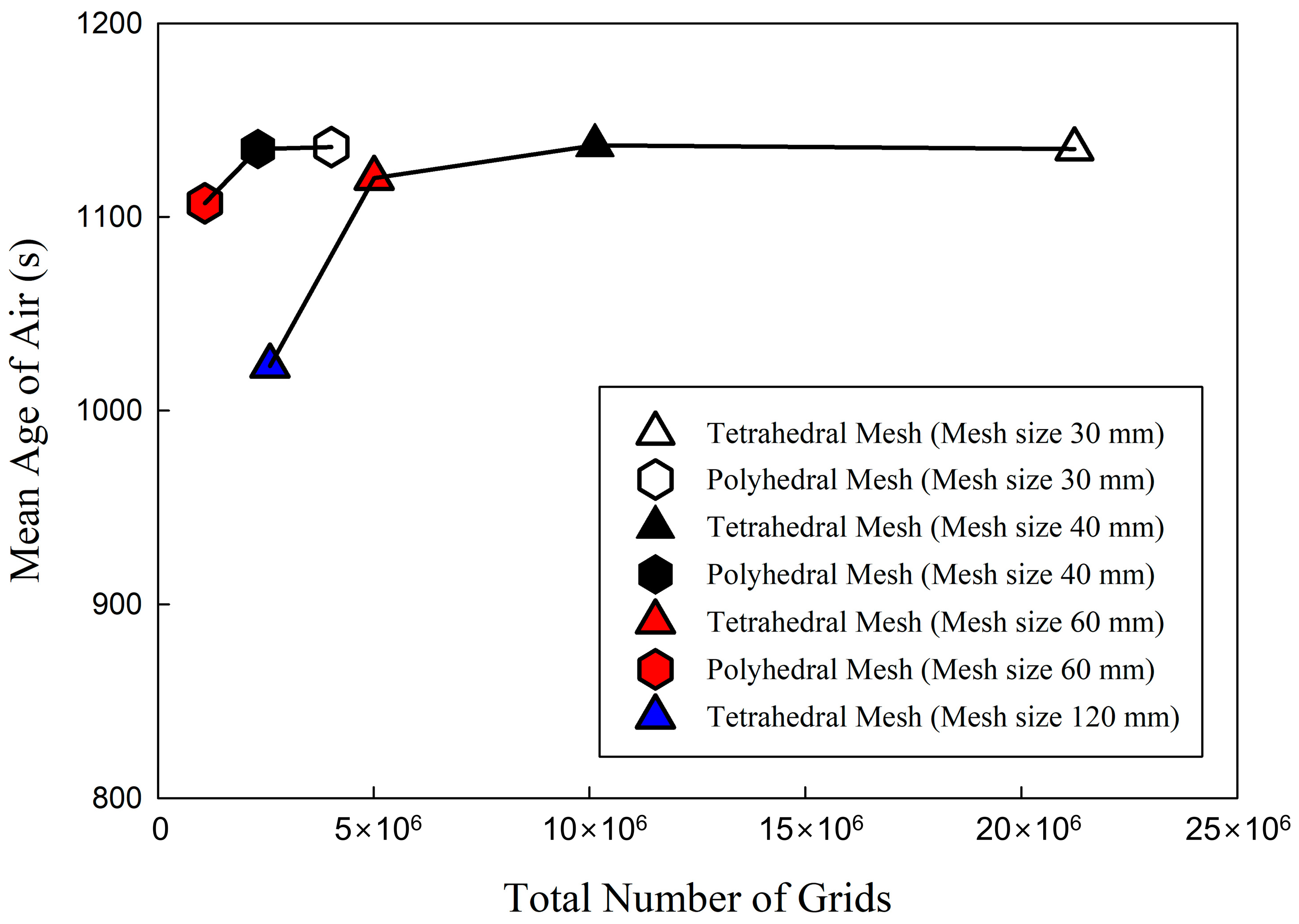
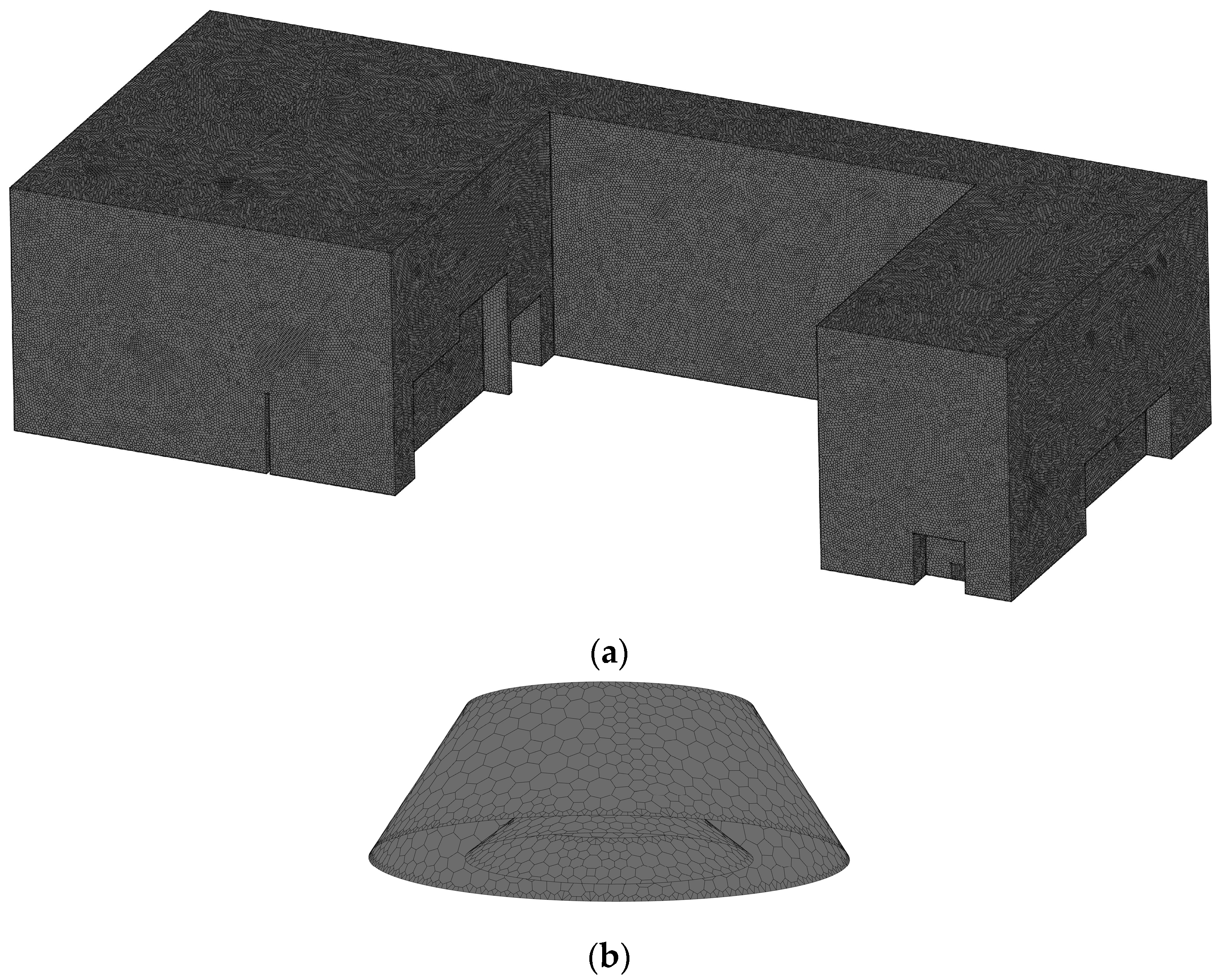
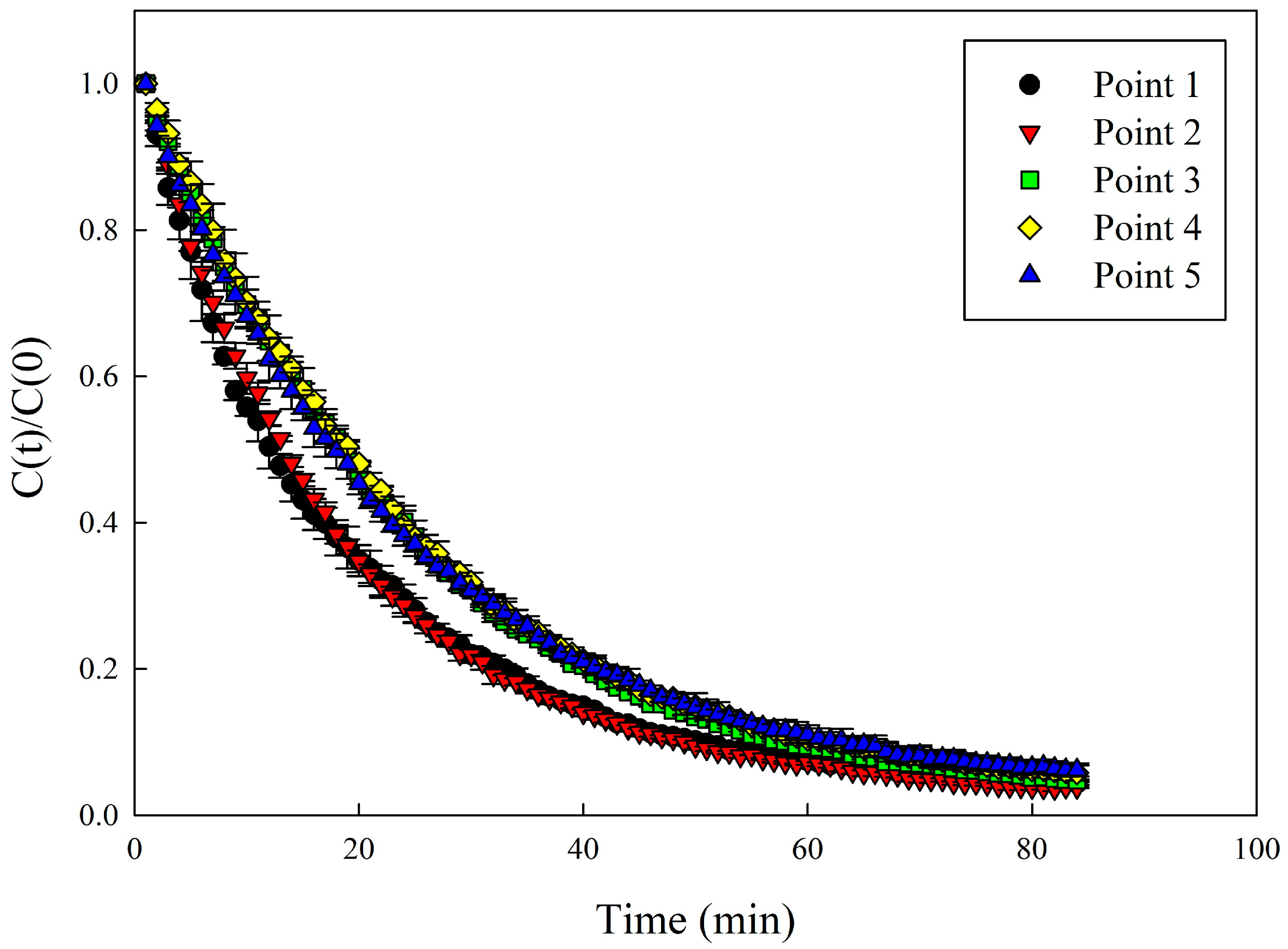
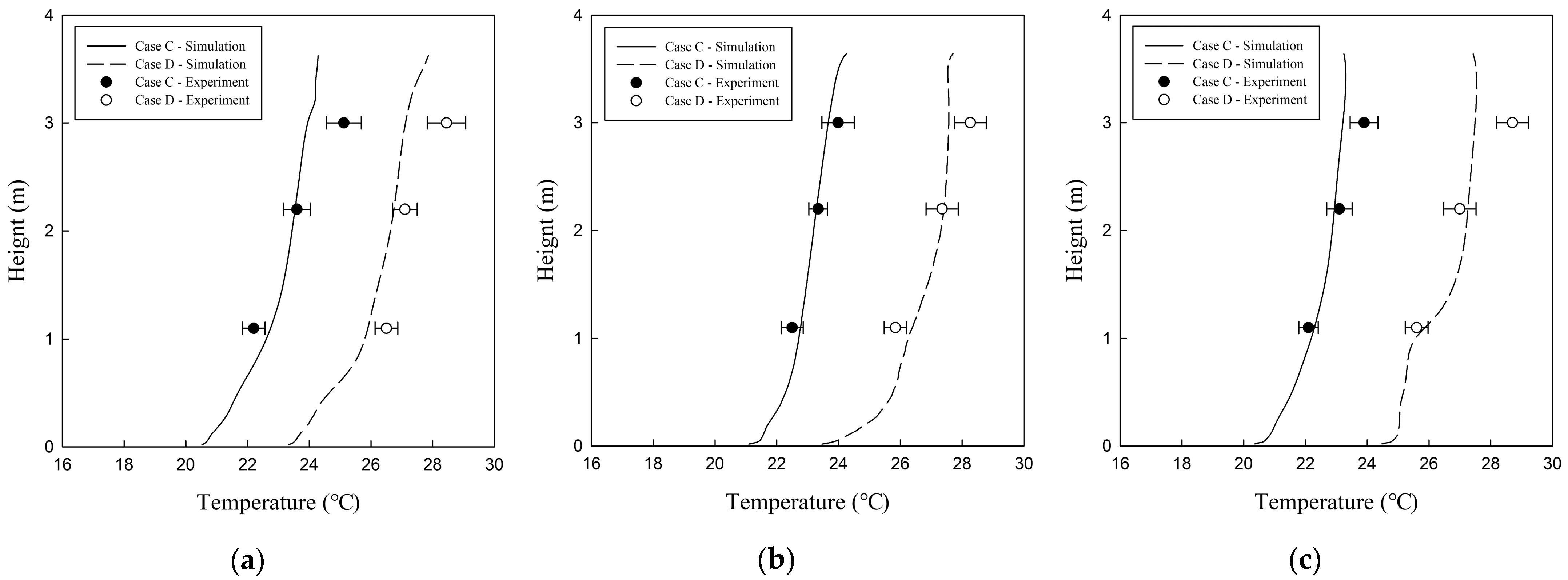
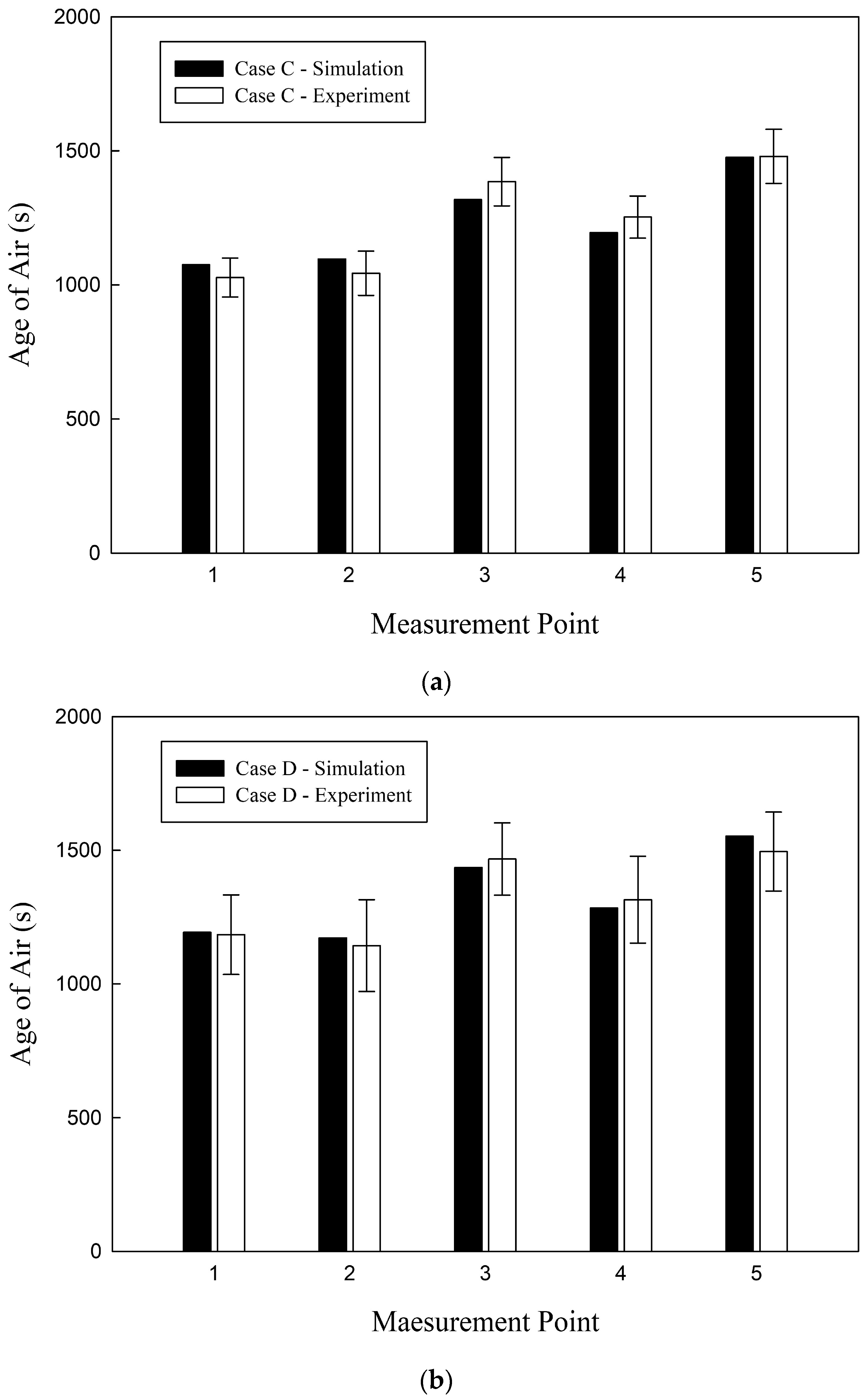
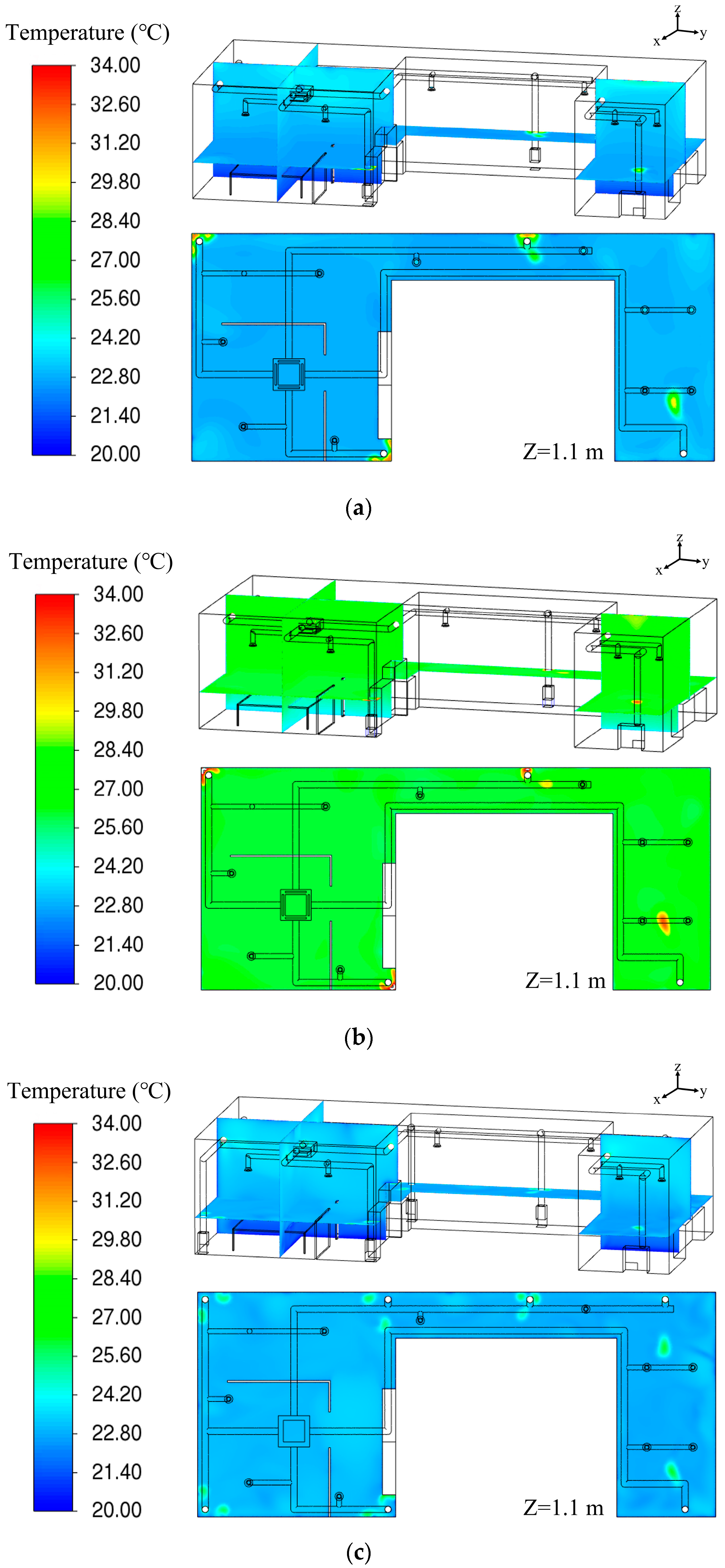

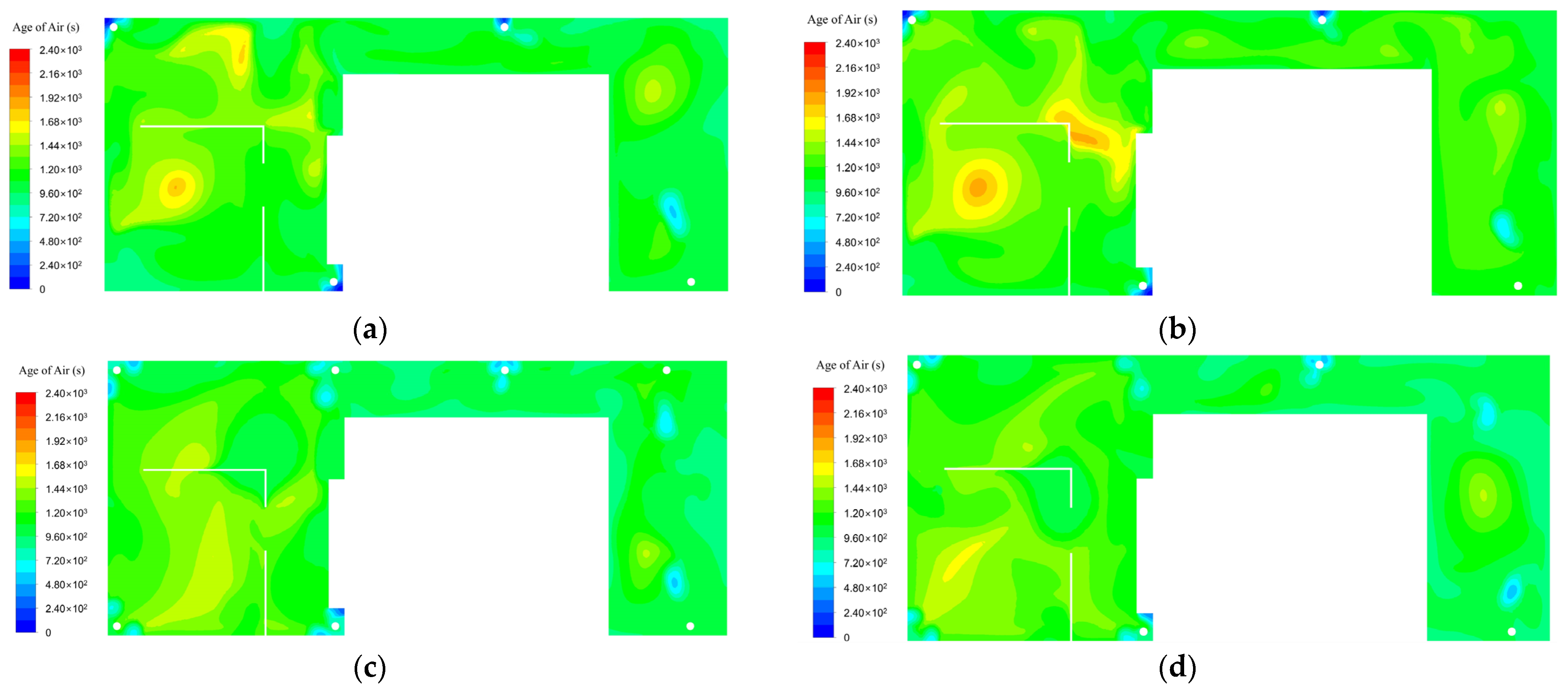



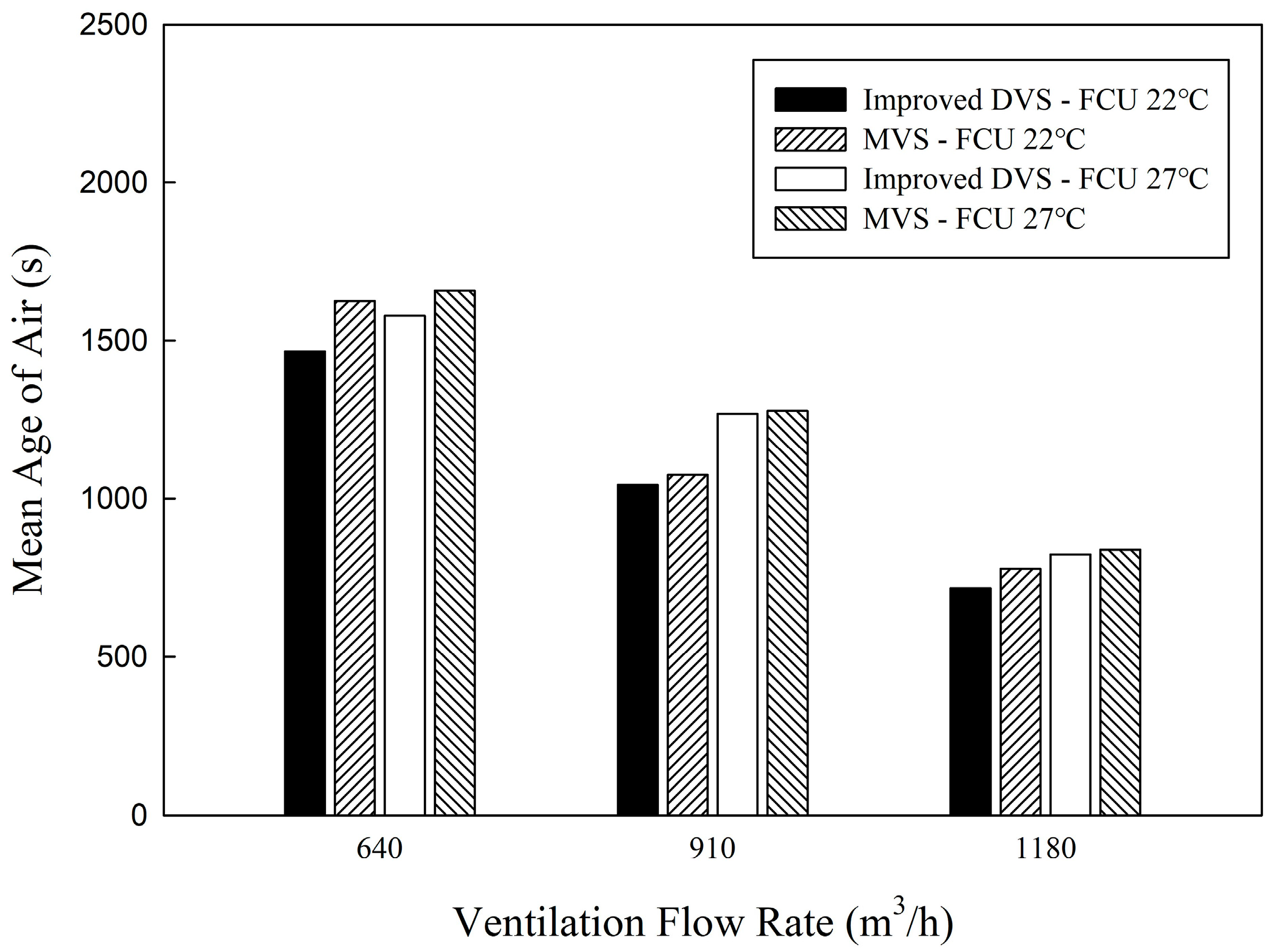
| Case | Ventilation Type | Ventilation Flowrate (m3/h) | Temperature Setting (°C) |
|---|---|---|---|
| A | DVS | 640 | 22 |
| B | 27 | ||
| C | 910 | 22 | |
| D | 27 | ||
| E | 1180 | 22 | |
| F | 27 | ||
| G | MVS | 640 | 22 |
| H | 27 | ||
| I | 910 | 22 | |
| J | 27 | ||
| K | 1180 | 22 | |
| L | 27 |
Disclaimer/Publisher’s Note: The statements, opinions and data contained in all publications are solely those of the individual author(s) and contributor(s) and not of MDPI and/or the editor(s). MDPI and/or the editor(s) disclaim responsibility for any injury to people or property resulting from any ideas, methods, instructions or products referred to in the content. |
© 2024 by the authors. Licensee MDPI, Basel, Switzerland. This article is an open access article distributed under the terms and conditions of the Creative Commons Attribution (CC BY) license (https://creativecommons.org/licenses/by/4.0/).
Share and Cite
An, I.-H.; Park, S.-H.; Lee, Y.-H.; Lee, C.-H.; Seo, S.-B.; Cho, S.-H.; Lee, H.-W.; Yook, S.-J. Comparison of Local Mean Age of Air between Displacement Ventilation System and Mixing Ventilation System in Office Heating Conditions during Winter. Buildings 2024, 14, 115. https://doi.org/10.3390/buildings14010115
An I-H, Park S-H, Lee Y-H, Lee C-H, Seo S-B, Cho S-H, Lee H-W, Yook S-J. Comparison of Local Mean Age of Air between Displacement Ventilation System and Mixing Ventilation System in Office Heating Conditions during Winter. Buildings. 2024; 14(1):115. https://doi.org/10.3390/buildings14010115
Chicago/Turabian StyleAn, Ik-Hyun, Su-Hoon Park, Yong-Ho Lee, Chang-Hoon Lee, Sang-Bum Seo, Sang-Hyun Cho, Hyun-Woo Lee, and Se-Jin Yook. 2024. "Comparison of Local Mean Age of Air between Displacement Ventilation System and Mixing Ventilation System in Office Heating Conditions during Winter" Buildings 14, no. 1: 115. https://doi.org/10.3390/buildings14010115
APA StyleAn, I.-H., Park, S.-H., Lee, Y.-H., Lee, C.-H., Seo, S.-B., Cho, S.-H., Lee, H.-W., & Yook, S.-J. (2024). Comparison of Local Mean Age of Air between Displacement Ventilation System and Mixing Ventilation System in Office Heating Conditions during Winter. Buildings, 14(1), 115. https://doi.org/10.3390/buildings14010115









